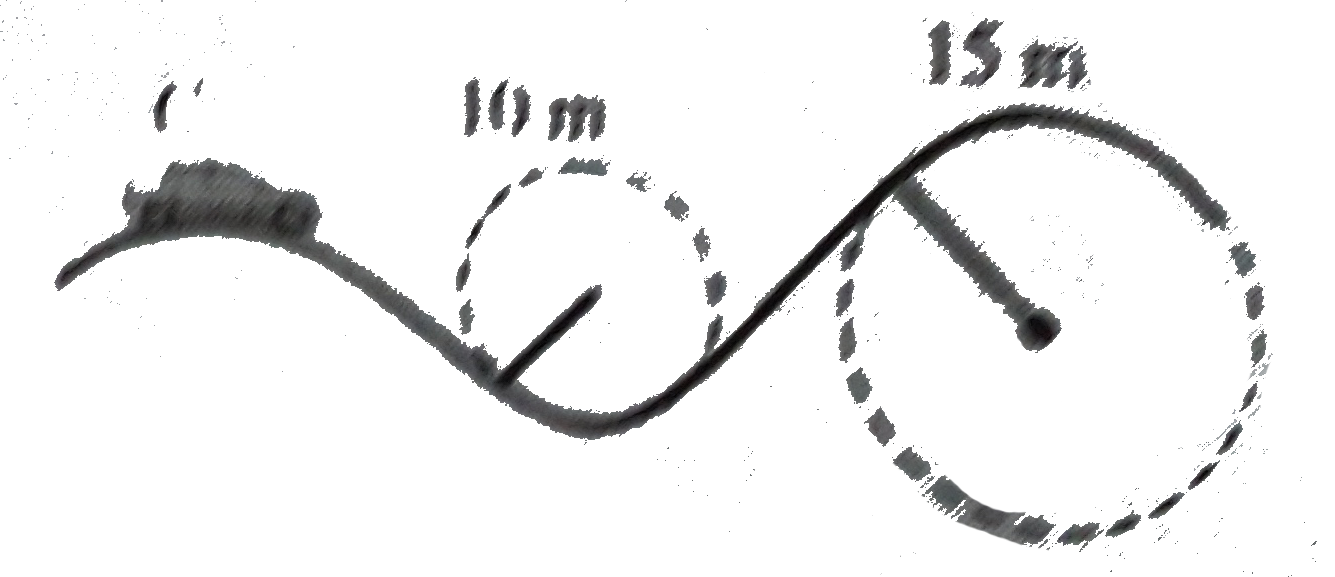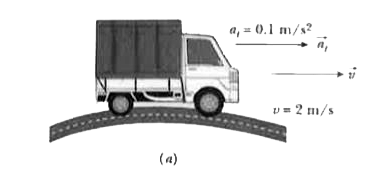A roller coaster car has mass of 1300 kg when fully loaded with passengers. As the car passes over the top of a circular hil of radius 20m, its speed is not changing. At the top of the hill, what are the (a) magnitude FN and (b) direction (up or down) of the normal force on the car from the track if the car's speed is v=11m/s? What are (C) FN and (d) the direction if v=14m/s?
The correct Answer is:(a)4.9×10(3)N; (b) upward (c) 0N; (d) No direction sicne the normal force is zero.
To solve the problem, we need to analyze the forces acting on the roller coaster car as it passes over the top of a circular hill. We will use the concepts of centripetal force and Newton's second law.
Given Data:
- Mass of the roller coaster car, m=1300kg
- Radius of the circular hill, r=20m
- Gravitational acceleration, g=9.8m/s2
Part (a): Finding the Normal Force FN when v=11m/s
1. Calculate the gravitational force Fg:
Fg=m⋅g=1300kg⋅9.8m/s2=12740N
2. Calculate the centripetal force Fc required to keep the car moving in a circular path:
Fc=m⋅v2r=1300kg⋅(11m/s)220m=1300⋅12120=7875N
3. Set up the equation for forces at the top of the hill:
At the top of the hill, the gravitational force acts downward, and the normal force FN acts upward. The net force towards the center of the circular path is given by:
Fg−FN=Fc
Rearranging gives:
FN=Fg−Fc
4. Substitute the values:
FN=12740N−7875N=4865N
Part (b): Direction of the Normal Force
The normal force FN is positive, indicating that it acts upward.
Part (c): Finding the Normal Force FN when v=14m/s
1. Calculate the centripetal force Fc for v=14m/s:
Fc=m⋅v2r=1300kg⋅(14m/s)220m=1300⋅19620=12740N
2. Set up the equation for forces at the top of the hill:
Fg−FN=Fc
Rearranging gives:
FN=Fg−Fc
3. Substitute the values:
FN=12740N−12740N=0N
Part (d): Direction of the Normal Force
Since FN=0N, there is no normal force acting on the car at this speed. Thus, the direction is undefined.
Summary of Results:
- (a) Magnitude of FN when v=11m/s: 4865N
- (b) Direction of FN: Upward
- (c) Magnitude of FN when v=14m/s: 0N
- (d) Direction of FN: Undefined (no normal force)
- Mass of the roller coaster car, m=1300kg
- Radius of the circular hill, r=20m
- Gravitational acceleration, g=9.8m/s2
Fg=m⋅g=1300kg⋅9.8m/s2=12740N
Fc=m⋅v2r=1300kg⋅(11m/s)220m=1300⋅12120=7875N
At the top of the hill, the gravitational force acts downward, and the normal force FN acts upward. The net force towards the center of the circular path is given by:
Fg−FN=Fc
Rearranging gives:
FN=Fg−Fc
FN=12740N−7875N=4865N
The normal force FN is positive, indicating that it acts upward.
Fc=m⋅v2r=1300kg⋅(14m/s)220m=1300⋅19620=12740N
Fg−FN=Fc
Rearranging gives:
FN=Fg−Fc
FN=12740N−12740N=0N
Since FN=0N, there is no normal force acting on the car at this speed. Thus, the direction is undefined.
- (a) Magnitude of FN when v=11m/s: 4865N
- (b) Direction of FN: Upward
- (c) Magnitude of FN when v=14m/s: 0N
- (d) Direction of FN: Undefined (no normal force)
Topper's Solved these Questions
- BOOK - RESNICK AND HALLIDAYCHAPTER - CIRCULAR MOTIONEXERCISE - PRACTICE QUESTIONS(SINGLE CORRECT CHOICE TYPE)40videos
CIRCULAR MOTION
- BOOK - RESNICK AND HALLIDAYCHAPTER - CIRCULAR MOTIONEXERCISE - PRACTICE QUESTIONS(MORE THAN ONE CORRECT CHOICE TYPE)6videos
CIRCULAR MOTION
- BOOK - RESNICK AND HALLIDAYCHAPTER - CIRCULAR MOTIONEXERCISE - CHECK POINTS6videos
CIRCULAR MOTION
- BOOK - RESNICK AND HALLIDAYCHAPTER - CIRCUITSEXERCISE - Practice Questions (Integer Type)3videos
CIRCUITS
- BOOK - RESNICK AND HALLIDAYCHAPTER - CURRENT AND RESISTANCEEXERCISE - Practice Questions (Integer Type)3videos
CURRENT AND RESISTANCE
Similar Questions
An amusement park ride consists of a car mvoing an a vertical circle on the end of a rigid boom of negligible mass. The combined weight of the car and riders is 6.0 kN, the circle's radius is 10m. At the top of the circle, what are the (a) magnitude FB and (b) direction (up or down) of the force on the car from the boom if the car's speed is v=5.0m/s? What are (c) FB and (d) the direction if v=12m/s?
View SolutionA roller -coaster car a mass of 500kg when fully loaded with passengers

a. If the vehicle has a speed of 20.0ms−1 at point what is the force exerted by the track on the car at this point ?
b. What is the maximum speed the vehicle can have point B and still remain on the track?View Solution
Knowledge Check
- Question 1 - Select One
A roller coaster is designed such that riders experience "weightlessness" as they go round the top of a hill whose radius of curvature is 20m. The speed of the car at the top of the hill is between
A14m/s and 15m/sB15m/s and 16m/sC16m/s and 17m/sD13m/s and 14m/s - Question 2 - Select One
A car is moving with speed 30m/sec on a circular path of radius 500 m . Its speed is increasing at the rate of , 2m/sec2, What is the acceleration of the car
A2m/sec2B2.7m/sec2C1.8m/sec2D9.8m/sec2 - Question 3 - Select One
A Roller coaster is desigend such that riders experience "Weightlessness " as they go round the top of a hill whose radius of curvature is 20 m. The speed of the car at the top of the hill is between
A15m/sand16m/sB16m/sand17m/sC13m/sand14m/sD14m/sand15m/s
A truck increases its speed at constant rate of 0.1m/s2 and it passes over a semicircular bridge of radius 40 m. At the time car reaches the top of the bridge, its speed is 2m/s. What are the magnitude and direction of the to total acceleration vector at this moment?
 View Solution
View SolutionA car of maas M is moving on a horizontal circular path of radius r. At an instant its speed is v and is increasing at a rate a.
View SolutionThe speed of a car is 54km/hr. What is its speed in m/sec?
View SolutionA car is moving at a speed of 40 m/s on a circular track of radius 400 m. Its speed is increasing at the rate of 3 m/s2. The acceleration of car is
View SolutionA car has a linear velocity v on a circular track of radius r. IF its speed is increasing at a rate of am/s2, , then its resultant acceleration will be
View Solution

